
Enchanted April, at least along Italy's Lake Como, means one of the world's most heralded classic car shows, the Concorso d'Eleganza Villa d'Este
There’s something about spring in Northern Italy that makes you feel like you’ve stepped onto a movie set. Maybe it’s the soft light or the gentle breeze as our boat slowly rounds a bend on Lake Como and the lush grounds of Villa d’Este suddenly come into sight.
At first, the palatial hotel, with its trompe l’oeil columns, dominates the vista, but as we draw closer, we remember the reason we’re here, dozens of classic cars sprawling across the estate’s grounds.
The Concorso Eleganza Villa d’Este is neither the first classic car show of the season, nor the largest. But it is perhaps the most charming and delightful, a setting even more lovely than the grounds of Pebble Beach and a collection of rare and amazing automobiles that few, if any, other Concours can match.
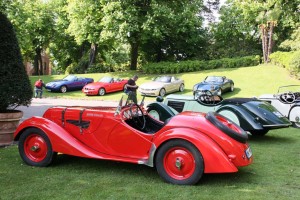
BMW showcased a complete collection of roadsters, dating back 75 years, from the original 315/1 to the new, 2009 Z4.
The 2009 Concorso marked a series of special occasions, starting with its own, 80th anniversary. Launched in the golden era of European motoring, between the Wars, more than a few of the models on display, this year, might have driven to Italy’s lake country, in 1929, for the first show at Villa d’Este, itself a grand retreat for Europe’s elite.
BMW the show’s prime sponsor, for the past decade, marked its own 80th with an exhibition of products from its earliest years, including the legendary 303, the Bavarian makers first sports car to sport the familiar BMW kidney grille. The marque also brought to the Concorso every one of the roadsters it has produced, over the last 75 years, starting with the original 315/1, up to and including the newly-redesigned 2009 BMW Z4, the first for the automaker with a retractable hardtop. (Click here to read a new review of the ’09 Z4.)
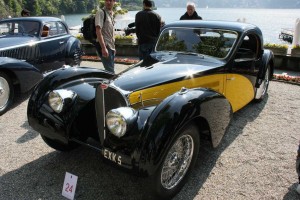
Only three copies of the legendary Bugatti Atlantic were produced.
In all, more than 50 cars were invited to compete on the Villa d’Este grounds, including a surprisingly rich collection of Bugatti road and track models. It was a fitting turnout, considering 2009 marks the legendary brand’s centennial. While it’s never easy to win a debate over which Bugatti is the rarest or the most beautiful, the Atlantic 57SC that was put on display at the Villa certainly wins many arguments.
Though the Type 57 was, for Bugatti, a relatively high-volume model, only three of the Atlantic bodies were hand-crafted, in 1938. Its iconic design is distinguished by a crouched stance, vertical, riveted ribs and unusual, teardrop-shaped windows. The last of the three Atlantics, the model on display at Villa d’Este was kept by its original owner until 1967. It changed hands several times before being purchased, in 1988, by fashionista and avid classic car fan, Ralph Lauren, who put it through a full restoration.
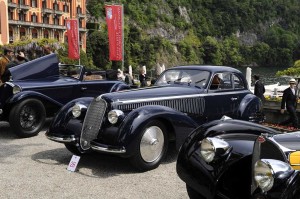
Grand Prize winner at this year's Concorso d'Eleganza Villa d'Este was this equally rare Alfa Romeo 8C.
Yet despite the Atlantic’s first visit to a European Concours in nearly two decades, the real attention grabber – and big winner during the Villa d’Este weekend – proved to be another 1938 rarity, an Alfa Romeo 8C 2900B. The design, known as the Berlinetta, was first unveiled in 1935, but during its entire run, the Italian maker produced just six examples of the closed car, often considered one of the most elegant automobiles to emerge from Europe in the years before World War II.
While the very nature of a Concours suggests antique, and typically pre-War cars, part of Villa d’Este’s appeal is the breadth of its offerings, some relatively recent by classic car definition.
In 1967, Peter was considering whether to buy an Aston Martin. Instead, he came up with an alternative idea, one that would not sit well with his well-heeled family. But despite their best efforts to dissuade him, Kalikow teamed up with Alfred Momo, a New York automotive specialist, to develop the Momo Mirage 2+2 Coupe. The four-seat sports car had an unusual mission: it was to be distinctively American, yet fill the gap between a spirited Ferrari and a lavish, luxurious Rolls-Royce. The partners never met their original goal of turning out 25 of the Coupes a year, due to harsh economic realities. Of the five ultimately built, Kalikow kept three, including one shown at Villa d’Este.
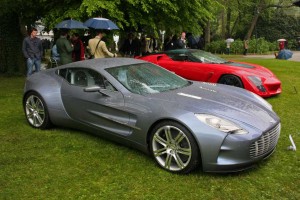
Despite the deluge, on Sunday, the crowds made the prototype Aston Martin One-77 one of their favorites. Production begins in 2010.
For all their rarity, however, the most unique models are the one-off concept cars that manufacturers as mainstream as Chevrolet and as up-market as Rolls-Royce have produced, over the decades – some to titillate the public, others to help company planners decide on a specific design. The 2009 Concorso d’Eleganza featured a surprising assortment of these prototypes, new and old, including an alternate version of Rolls’ 200EX, which will go into production as he 2010 Ghost. (Click here to find out more about the new “small” Rolls by clicking here.)
Aston Martin has spent the last year teasing the public with partial views of its One-77, but waited until the ’09 Concorso to pull the wraps off a full-sized running prototype of the new supercar – which you can read more about by clicking here. Aston, incidentally, took home the Concept and Prototype award for its One-77.
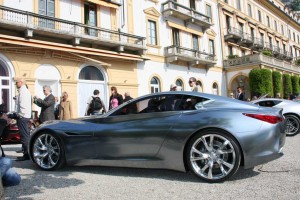
The Infiniti Essence concept car was a favorite at both the Geneva Motor Show and at Villa d'Este.
Not to be outdone, Nissan’s luxury marque, Infiniti, staged a version of its new Essence concept, considered by many to be the most striking vehicle, production or prototype, at the 2009 Geneva Motor Show. The long, low-slung sports car “suggests what is coming in our line-up,” hinted Shiro Nakamura, Nissan’s corporate design chief, as he posed with pictures with the Essence.
While concept vehicles, by their very nature, push the automotive boundaries, the Villa d’Este collection’s most unusual prototype, at least from a design standpoint, was a BMW one-off dubbed GINA Light. Conceived as an exercise in lightweight, high-mileage design, the show car is covered in a flexible Lycra skin that barely conceals the flexible steel understructure. GINA’s shape shifts as various functions are needed. The headlights, for example, remain concealed until needed, then literally wink open.
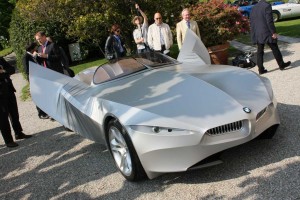
With its lycra skin, the BMW Gina concept vehicle can actually wink its headlights.
From an engineering standpoint, the real crowd-pleaser was the 1955 Gilda Streamline X Coupe Ghia. All its current owner, Scott Grundfor, had to do to draw a crowd was turn the key and let the Gilda’s 1500 cc turbine engine fire up with a scream. Turbine engines commanded a lot of interest, in the 1950s and ’60s, with a variety of makers, including General Motors and Chrysler, exploring their capabilities. But despite their tremendous power – the Gilda was rated at a “theoretical: top speed of 150 mph – they had numerous disadvantages that eventually convinced industry engineers to look elsewhere.
Commissioned by Chrysler, the Ghia concept explored not only the use of a turbine engine, but also the potential limits of streamlined design, explained Grundfor, of Arroyo Grande, California. That included “the legitimate use of the tailfin,” he noted, for both high-speed stability and steering.
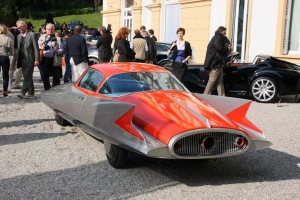
Commissioned by Chrysler, Ghia's Gilda concept vehicle explored both aeroydnamics and the potential uses of a turbine engine.
As the old nursery rhyme reminds us, April is a month of showers. Those media and invited guests who made the Saturday preview of the Concorso enjoyed some of the best weather spring can bring to Italian lake country. But the public received a much soggier welcome, on Sunday. Despite the damp and cold, the turnout was heavy, reflecting the timeless appeal of rare and unusual automobiles.

I´ve seen a colorfull video about the last Concorso on
http://www.classic-car-tv.com/oldtimer/DE/news/index.php?Seite=164
A great film, giving an impression of this charming classic car show.
What an outrageous article. I am sure you are enjoying the decadence as you enjoy the perks of auto journalists who pimp as they enjoy the fruit of their pimps.
LOL, Silvio, thanks for your comments. As anyone who knows my 30 years of work, I don’t exactly qualify as either pimp or whore. And if I happen to enjoy a classic car event, well, I’m not quite sure that goes into the high crimes and misdemeanors category. But I appreciate your concerns and thank you for your post.
Paul A. Eisenstein
Bureau Chief, TheDetroitBureau.com
Dear Mr. Eisenstein,
thank you for this rare look through the window in another world. I enjoyed it.
R.Renner
You’re quite welcome. It was my delight to actually get to attend a show I’d only read about elsewhere for so many years. You know something is wonderful if you’re still smiling despite the pouring rain.
Paul A. Eisenstein
Bureau Chief, TheDetroitBureau.com